Antarctica, the southernmost continent and site of the South Pole, is a virtually uninhabited, ice-covered landmass.
The peninsula’s isolated terrain also shelters rich wildlife, including many penguins.
It’s the driest and coldest place on Earth and yet around 235 animal species call Antarctica home. Overall, over 1,142 species (including lichens, mosses and marine invertebrates) thrive on and around the White Continent.
I was fortunate to visit this remarkable place during a week long cruise, where we made several outings to the land and cruised around on the zodiac, watching whales, seals and penguins in their natural habitat.


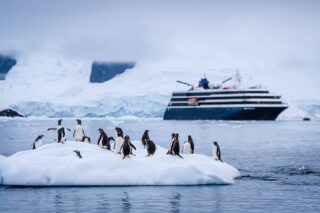



Our first stop was Deception Island, a sunken, flooded caldera of an active volcano in the South Shetland Islands.
Its unique landscape comprises barren volcanic slopes, steaming beaches and ash-layered glaciers. It has a distinctive horse-shoe shape with a large flooded caldera.
Eruptions in 1968 and 1970 forced a British scientific research station to close, sending mud and ash through it and the nearby abandoned whaling station.



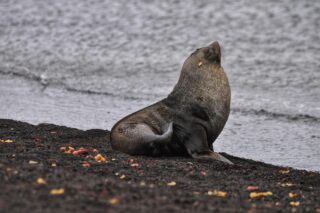

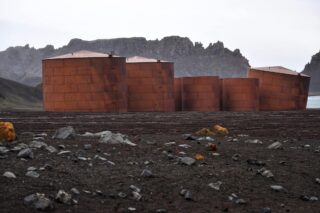
Summer weather in the White Continent is surprisingly mild.
During this time, the sun is almost always in the sky. Days rapidly get longer there in summer, until, eventually, the sun doesn’t set at all. This phenomenon is called the Midnight Sun.
The Antarctic Peninsula is warming approximately six times faster than the global average, and the ice shelves surrounding it are thinning. Although the region appears untouched by human hands, climate effects are far reaching, and Antarctica is very fragile.
Cuverville Island stands at the entrance of Errera Channel and is flanked by the precipitous mountains and glaciers of the Antarctic mainland.
This island is well-known for its great variety of wildlife and massive population of Gentoo penguins. About 6,500 breeding pairs of gentoos call Cuverville home, composing the largest rookery on the Antarctic Peninsula.
With flamboyant red-orange beaks, white-feather caps, and peach-colored feet, gentoo penguins stand out against their drab, rock-strewn Antarctic habitat.
These charismatic waddlers, who populate the Antarctic Peninsula and numerous islands around the frozen continent, are the penguin world’s third largest members, reaching a height of 30 inches and a weight of 12 pounds.
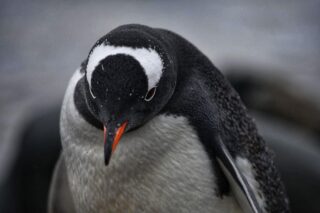




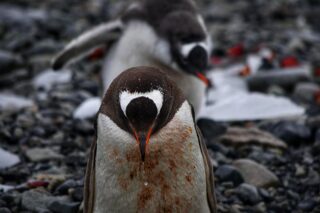
Orne Harbor is a small cove, indenting the west coast of Graham Land southwest of Cape Anna along the Danco Coast on the west side of the Antarctic Peninsula. A colony of chinstrap penguins lives here.
The chinstrap penguin is a species of penguin that inhabits a variety of islands and shores in the Southern Pacific and the Antarctic Oceans. Its name stems from the narrow black band under its head, which makes it appear as if it were wearing a black helmet, making it easy to identify.
Chinstrap penguins may be the most abundant penguin, with a population estimated at 7.5 million breeding pairs. They are considered to be the most aggressive of all penguins.
In the water, where they feed primarily on krill, the penguins’ main predator is the leopard seal. On land, chinstraps face threats from skuas, giant petrels, and other birds that steal the penguins’ eggs and attack chicks.
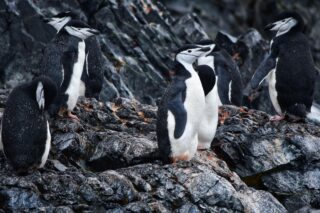


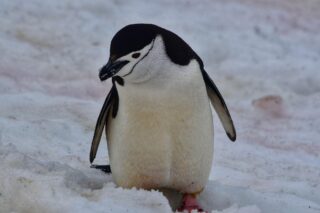

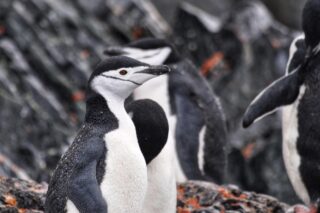
The Yalour Islands are a long group of small islands and protruding rocks off Cape Tuxen in Graham Land and the Wilhelm Archipelago. The islands were discovered and named in 1903 by the French Antarctic expedition led by Charcot.
The site is recognized as being one of the southernmost recorded Gentoo penguin colonies that are expanding south, as well as large colony of Adelie penguins.
The Adélie is the littlest species of penguin in the Antarctic. It might look cute and a bit clumsy on land but don’t be fooled, these birds are feisty. They’ve been known to take on potential predators – seals or large seabirds – or even attack visiting researchers with their flippers.





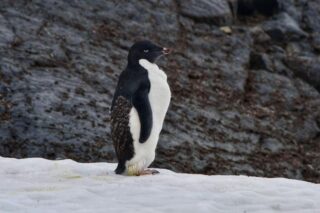
Six different species of seal live in Antarctic waters: Ross, Weddell, Crabeater, Leopard, Fur and Elephant seals.
Fur seals are the smallest, with adult females weighing only 330 lb/150 kg, while male elephant seals can weigh 8800 lb/4000 kg.
Southern elephant seals are the largest species of seal on the planet and a highlight among Antarctica wildlife.
Four of these species are ice-habitat specialists, breeding on the sea ice in spring. The Ross seal is however the rarest of the four seal species breeding on the Antarctic pack ice, and one population estimate has been made of about 220,000.


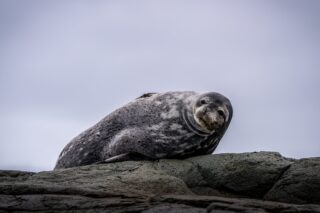



Lying between Booth Island and the Antarctic Peninsula, the Lemaire Channel measures almost seven miles long, five hundred feet deep, and just two thousand feet wide at the narrowest point.
The channel can be full of icebergs and sea ice, making navigation difficult. It has towering peaks on either side, topping 2,000 ft in height on either side of the channel. The deep waters of the channel hold seals, penguin, and whales.
Named after 19th-century Belgian explorer Charles Lemaire, who never actually set foot in Antarctica but rather was honored with the name of another Belgian explorer, Adrien de Gerlache. It was Gerlache who first explored the Lemaire Channel and this area of the Antarctic Peninsula in 1898, then chose to name the Channel after his fellow countryman.
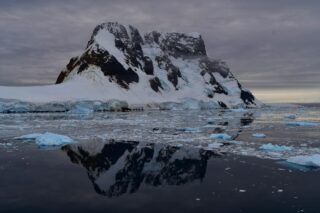
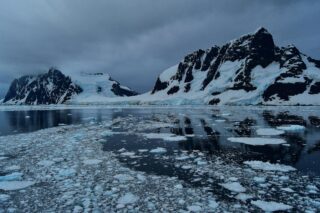
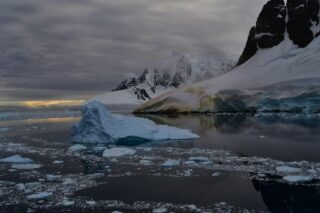



Damoy Point is a rocky headland on the west coast of Wiencke Island, near the northern entrance to the natural harbor at Port Lockroy. It was discovered and mapped by the French Antarctic expedition of 1903 led by Charcot.
There is a small British hut at Damoy Point that is a designated Historic Site. The British Antarctic Survey previously used this location, it was built in 1973 but is no longer in use.
Outside of this hut is an Argentinian refuge from the 1950s, now used only for emergencies.
Port Lockroy has been known as a safe anchorage following its use by the whaling fleets of the early 20th century and for this reason was selected for the first continuously occupied British base to establish year round British presence in Antarctica.
There is a nearly complete set of bones from a whale hunted over 100 years ago on the shore.
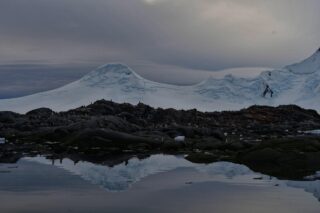





Paradise Bay — a harbor near Lemaire and Bryde Islands on the Antarctic Peninsula’s west coast. Home to huge whales, seals and fluffy penguins.
Paradise Bay is located just north of the Lemaire Channel and was once used by whale hunters as an anchorage for their floating factory ships in the early 20th century.
Brown Station is an Argentine Antarctic base and scientific research station named after Admiral William Brown, the father of the Argentine Navy. It is located on Sanavirón Peninsula along Paradise Harbor, Danco Coast, in Graham Land, Antarctic Peninsula.
The research done at Brown Station has led to considerable advancements across multiple disciplines, along with the publication of over 100 scientific papers by the Argentine Antarctic Institute. Biology, oceanography, glaciology, geophysics, ozone monitoring, ionospheric observations, and many other topics are studied at Brown Station.
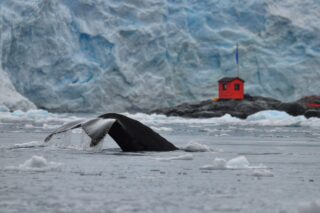


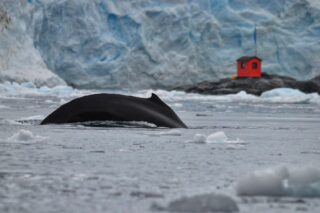


The whaling ship and floating factory, Neko, is where this scenic Antarctic bay got its name. Neko was stationed here from 1911―24 after the bay was discovered by Belgian explorer Adrien de Gerlache during his 1897―99 expedition. Gentoo penguins breed on the hill above Neko Harbor, while Weddell seals and fur seals often haul out on the beach.
Neko Harbor’s glacier is especially lively, frequently calving large chunks of ice that splash thunderously into the bay below.
Antarctica’s waters are rich with krill which serve as a vital food source for baleen whales. We have had several encounters with them at both Paradise Bay and Neko.




